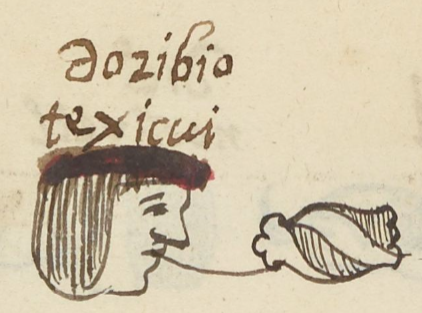Texicui (MH496r)
This black-line drawing of the simplex glyph for the personal name Texicui (here, attested as a man's name) shows a horizontal stone (tetl) with curling ends and dark and light alternating, diagonal stripes. The rest of the name is not obviously shown visually.
Stephanie Wood
This is a personal Nahua name, preceded in the gloss by a Christian first name (Toribio). He may have been named after Toribio de Benavente, also known as Motolinia ("One Who is Poor or Afflicted"). This was the first word he learned in Nahuatl, and he went on to learn the language well. He lived in the monastery in Huejotzingo. Doing a quick search for the name "Toribio" will produce an impressive result.
The Nahua glyph may have something to do with carving stones, or taking carved stones. Alternately, the Te- may be the nonspecific human object prefix and have nothing to do with stones at all, and if so, the stone is there as a phonetic indicator. (The glyph remains to be deciphered further.)
Stephanie Wood
doribio
texicui
Toribio Texicui
Stephanie Wood
1560
Jeff Haskett-Wood
stones, piedras, nombres de hombres

te(tl), stone, https://nahuatl.wired-humanities.org/content/tetl-0
xima, cut, shave, https://nahuatl.wired-humanities.org/content/xima
cui, to take, https://nahuatl.wired-humanities.org/content/cui
te, nonspecific human object prefix, https://nahuatl.wired-humanities.org/content/te
Matrícula de Huexotzinco, folio 496r, World Digital Library, https://www.loc.gov/resource/gdcwdl.wdl_15282/?sp=71&st=image
This manuscript is hosted by the Library of Congress and the World Digital Library; used here with the Creative Commons, “Attribution-NonCommercial-ShareAlike 3.0 License” (CC-BY-NC-SAq 3.0).




